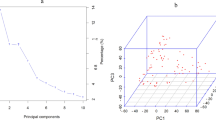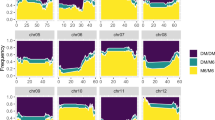Abstract
Genetic diversity of crop plants resulting from breeding and selection is preserved in gene banks. Utilization of such materials for further crop improvement depends on knowledge of agronomic performance and useful traits, which is usually obtained by phenotypic evaluation. Associations between DNA markers and agronomic characters in collections of crop plants would (i) allow assessment of the genetic potential of specific genotypes prior to phenotypic evaluation, (ii) identify superior trait alleles in germplasm collections, (iii) facilitate high resolution QTL mapping and (iv) validate candidate genes responsible for quantitative agronomic characters. The feasibility of association mapping was tested in a gene bank collection of 600 potato cultivars bred between 1850 and 1990 in different countries. The cultivars were genotyped with five DNA markers linked to previously mapped QTL for resistance to late blight and plant maturity. Specific DNA fragments were tested for association with these quantitative characters based on passport evaluation data. Highly significant association with QTL for resistance to late blight and plant maturity was detected with PCR markers specific for R1, a major gene for resistance to late blight, and anonymous PCR markers flanking the R1 locus at 0.2 Centimorgan genetic distance. The marker alleles associated with increased resistance and later plant maturity were traced to an introgression from the wild species S. demissum. These DNA markers are the first marker that are diagnostic for quantitative agronomic characters in a large collection of cultivars.
Similar content being viewed by others
References
Angeli M., Klewsaat M., Vandrey M., Schüler K. 2000. Kulturkart-offelsortiment/ Collection of Potato Varieties. 52 pp., Wilde und kultivierte Kartoffelarten aus Mittel-und Südamerika/wild and cultivated potato species from Central and South America, 123 pp. Inventory for 2000, IPK-Genbank Auβenstelle Groβ Lüse-witz.
Ballvora A., Ercolano M. R., Weiβ J., Meksem K., Bormann C., Oberhagemann P., Salamini F., Gebhardt C. 2002. The R1 gene for potato resistance to late blight (Phytophthora infestans) be-longs to the leucine zipper/NBS/LRR class of plant resistance genes. The Plant Journal 30: 361–371.
Collins A., Milbourne D., Ramsay L., Meyer R., Chatot-Balandras C., Oberhagemann P., De Jong W., Gebhardt C., Bonnel E., Waugh R. 1999. QTL for field resistance to late blight in potato are strongly correlated with earliness and vigour. Mol Breeding 5: 387–398.
Debener T., Salamini F., Gebhardt C. 1990. Phylogeny of wild and cultivated Solanum species based on nuclear restriction fragment length polymorphisms (RFLPs). Theor Appl Genet 79: 360–368.
Gebhardt C., Valkonen J. P. T. 2001. Organization of genes control-ling disease resistance in the potato genome. Annu Rev Phyto-pathol 39: 79–102.
Hanson W. D. 1959. The breakup of initial linkage blocks under se-lected mating systems. Genetics 44: 857–868.
Kamoun S. 2001. Nonhost resistance to Phytophthora: novel pros-pects for a classical problem. Curr. Opin. Plant Biol. 4: 295–300.
Kraft T., Hansen M., Nilsson N.-O. 2000. Linkage disequilibrium and fingerprinting in sugar beet. Theor. Appl. Genet. 101: 323–326.
Lander E. S., Schork N. J. 1994. Genetic dissection of complex traits. Science 265: 2037–2048.
Leonards-Schippers C., Gieffers W., Salamini F., Gebhardt C. 1992. The R1 gene conferring race-specific resistance to 101. Phytophthora infestans in potato is located on potato chromo-some V. Mol. Gen. Genet. 233: 278–283.
Leonards-Schippers C., Gieffers W., Schäfer-Pregl R., Ritter E., Knapp S. J., Salamini F., Gebhardt C. 1994. Quantitative resis-tance to Phytophthora infestans in potato: a case study for QTL mapping in an allogamous plant species. Genetics 137: 67–77.
Meksem K., Leister D., Peleman J., Zabeau M., Salamini F., Geb-hardt C. 1995. A high-resolution map of the vicinity of the R1 locus on chromosome V of potato based on RFLP and AFLP markers. Mol. Gen. Genet. 249: 74–81.
Oberhagemann P., Chatot-Balandras C., Bonnel E., Schäfer-Pregl R., Wegener D., Palomino C., Salamini F., Gebhardt C. 1999. A genetic analysis of quantitative resistance to late blight in po-tato: Towards marker assisted selection. Mol. Breeding 5: 399–415.
Risch N. J. 2000. Searching for genetic determinants in the new millennium. Nature 405: 847–856.
Ross H. 1986. Potato Breeding-Problems and Perspectives. J. Plant Breed. Suppl. 13.
Salamini F., Özkan H., Brandolini A., Schäfer-Pregl R., Martin W. 2002. Genetics and geography of wild cereal domestication in the near east. Nature Reviews Genetics 3: 429–441.
Schafer A. J., Hawkins J. R. 1998. DNA variation and the future of human genetics. Nature Biotechnology 16: 33–39.
Steineck O. 1956. Tageslänge und Knollenbildung bei Kultursorten der Kartoffel. Z. für Pflanzenzüchtung 36: 197–213.
Swiezynski K. M., Chrzanowska M., Domanski L., Zimnoch-Gu-zowska E. 2001. Comparison of resistance evaluation in potato variety assessment. Pot. Res. 44: 25–31.
Swiezynski K. M., Haynes K. G., Hutten R. C. B., Sieczka M. T., Watts P., Zimnoch-Guzowska E. 1997. Pedigree of European and North-American potato varieties. Plant Breeding and Seed Science 41, Supplement no. 1.
Thornsburry J. M., Goodman M. M., Doebley J., Kresovich S., Nielsen D., Buckler IV E. S. 2001. Dwarf8 polymorphisms asso-ciate with variation in flowering time. Nature Genetics 28: 286–289.
Visker M. H. P. W., Keizer L. C. P., Van Eck H. J., Jacobsen E., Colon L. T., Struik P. C. 2003. Can the QTL for late blight resistance on potato chromosome 5 be attributed to foliage maturity type? Theor. Appl. Genet. 106: 317–325.
Xiong M. I., Guo S. W. 1997. Fine-scale mapping of quantitative trait loci using historical recombinations. Genetics 145: 1201–1218.
Author information
Authors and Affiliations
Corresponding author
Rights and permissions
About this article
Cite this article
Gebhardt, C., Ballvora, A., Walkemeier, B. et al. Assessing genetic potential in germplasm collections of crop plants by marker-trait association: a case study for potatoes with quantitative variation of resistance to late blight and maturity type. Molecular Breeding 13, 93–102 (2004). https://doi.org/10.1023/B:MOLB.0000012878.89855.df
Issue Date:
DOI: https://doi.org/10.1023/B:MOLB.0000012878.89855.df




